Mathematical Models in Finances Valentina Desnitskaya Val. desnitskaya@mail.
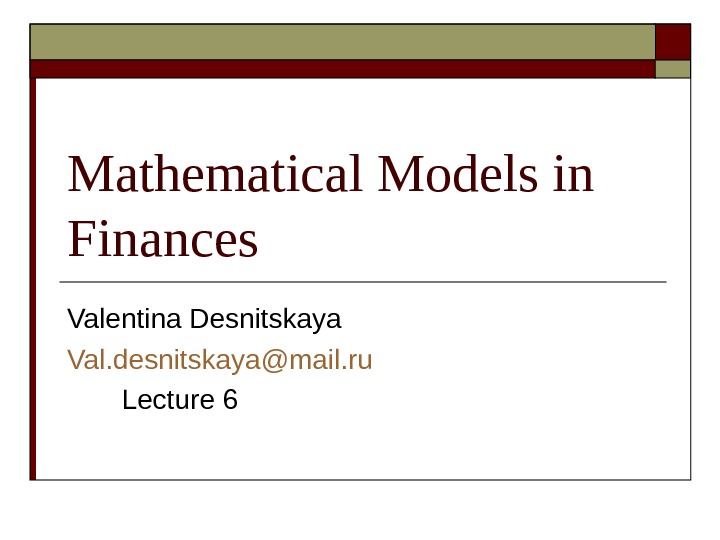

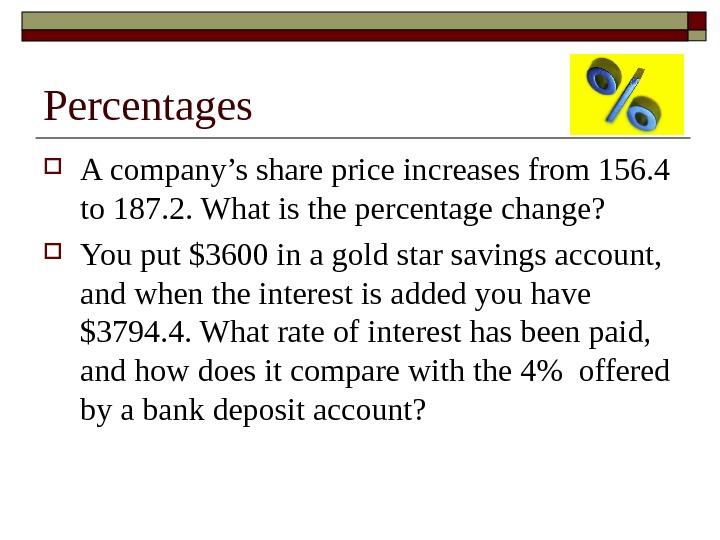
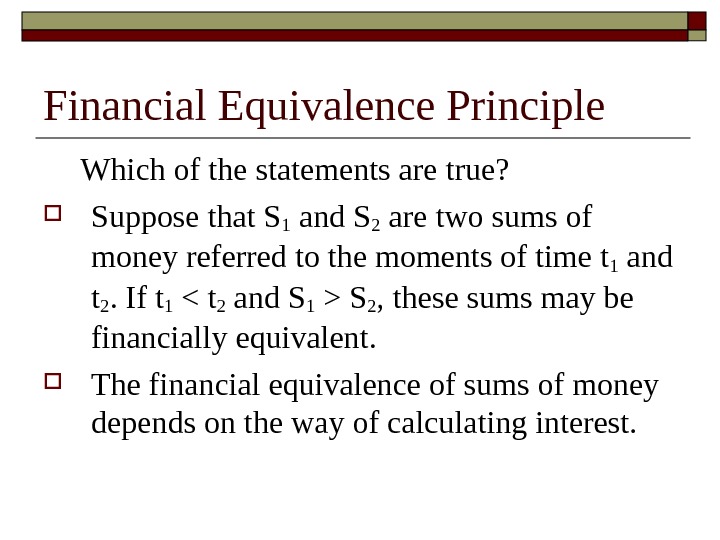
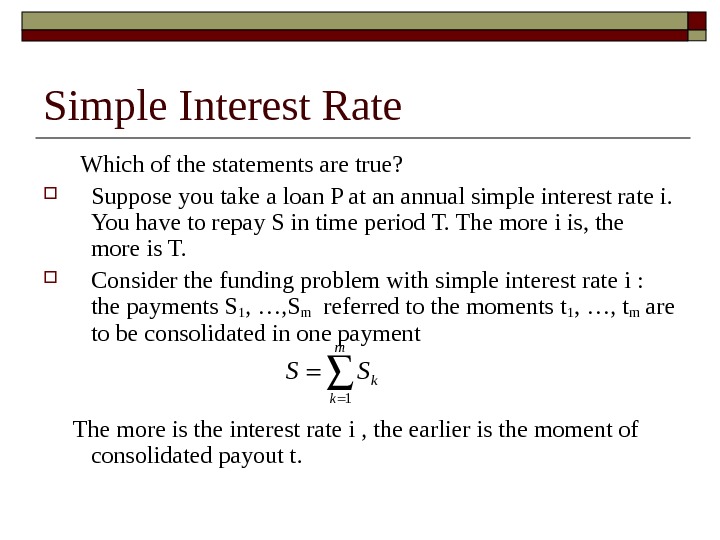
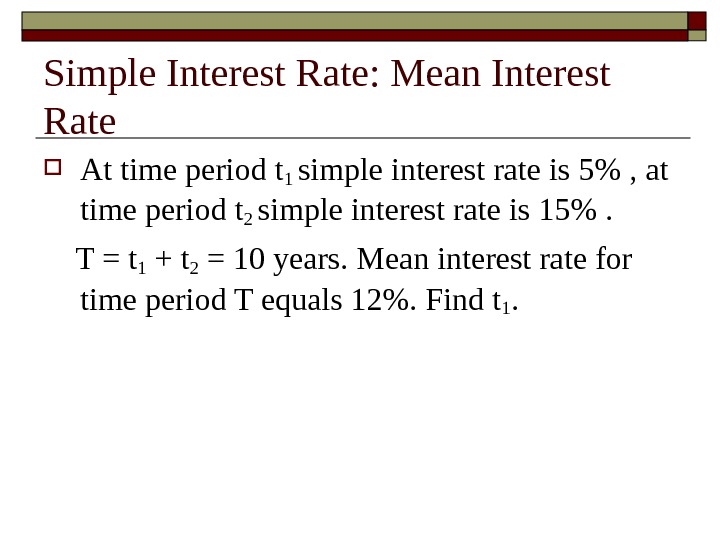
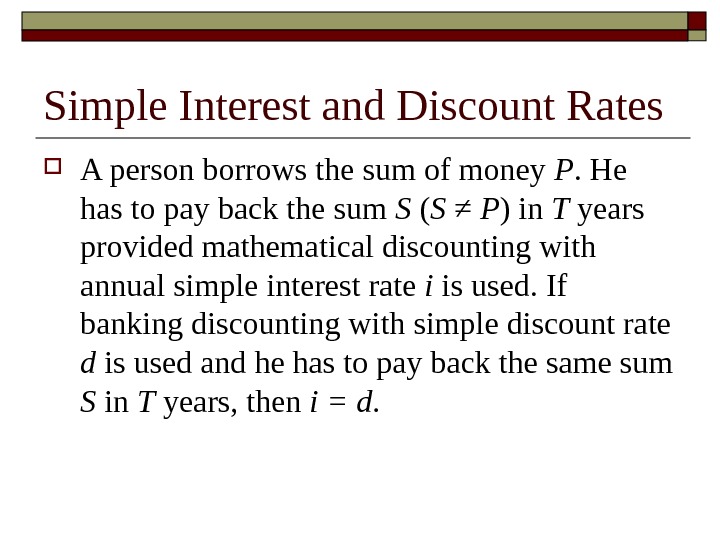
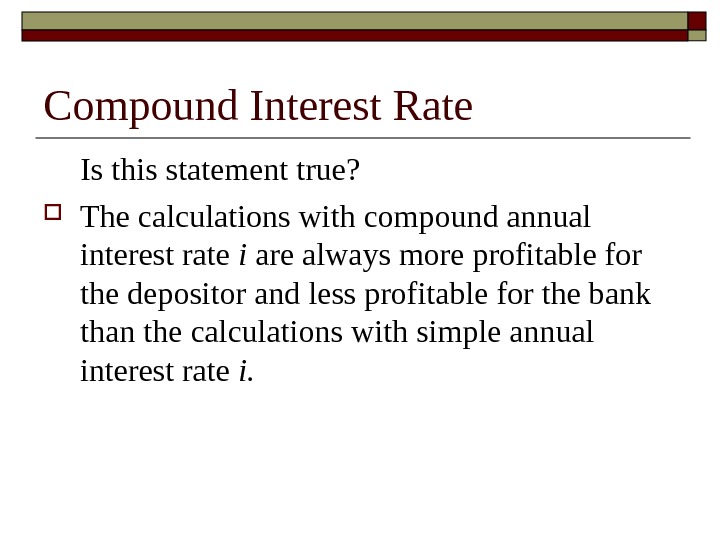
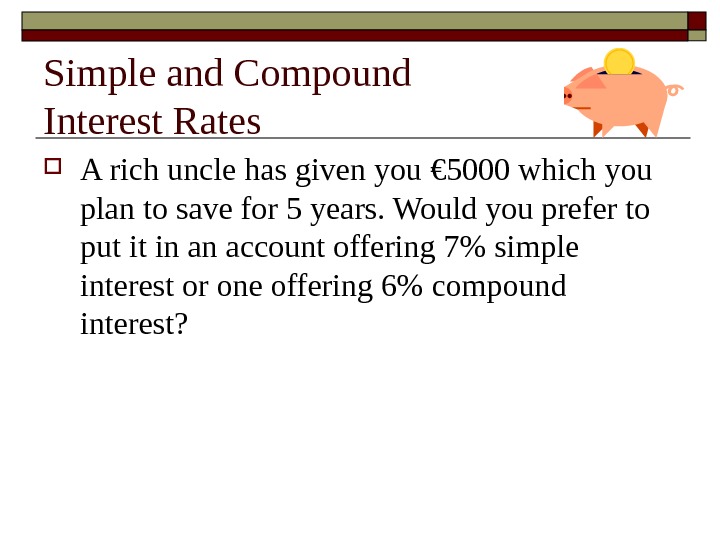
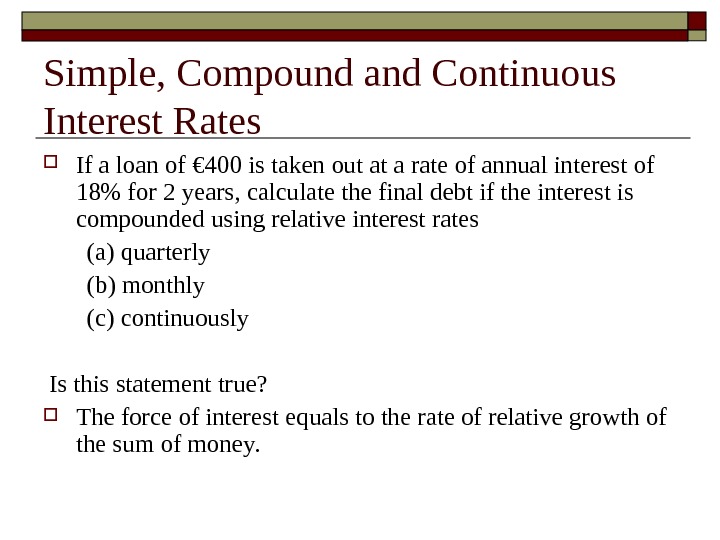

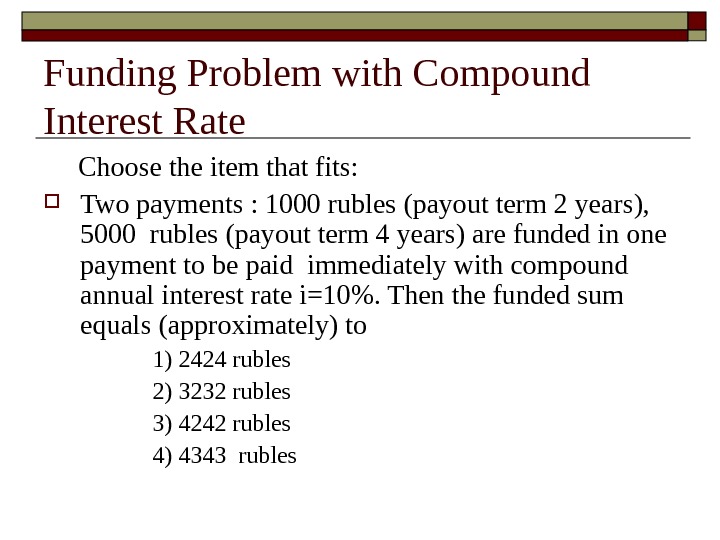
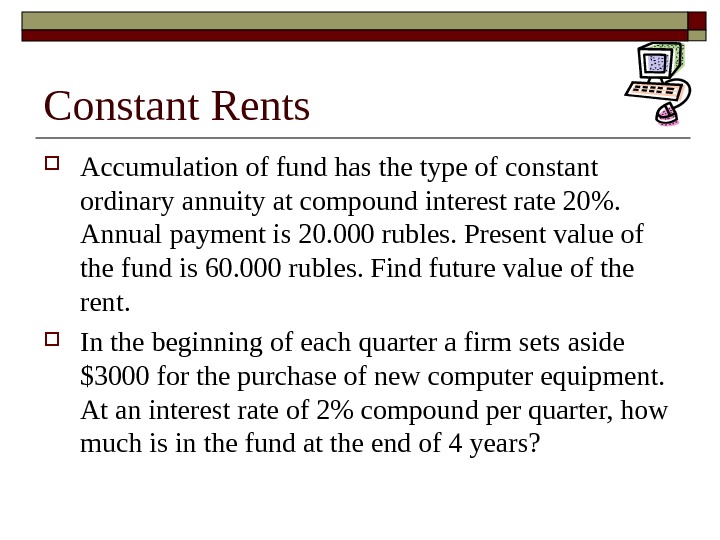
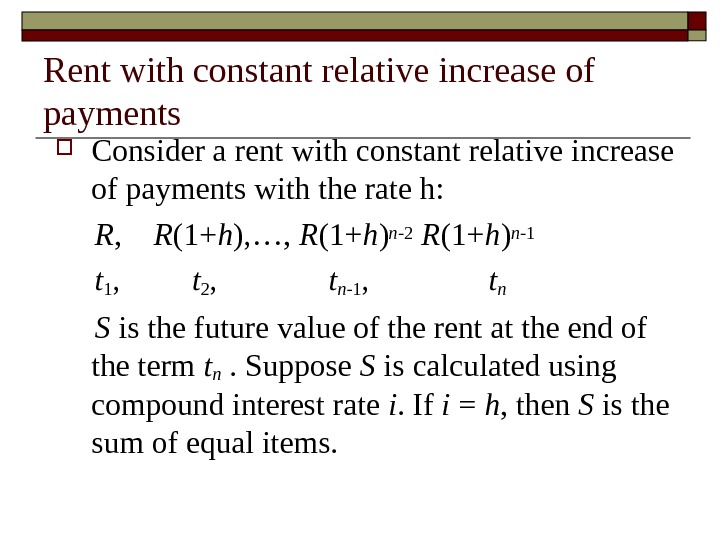
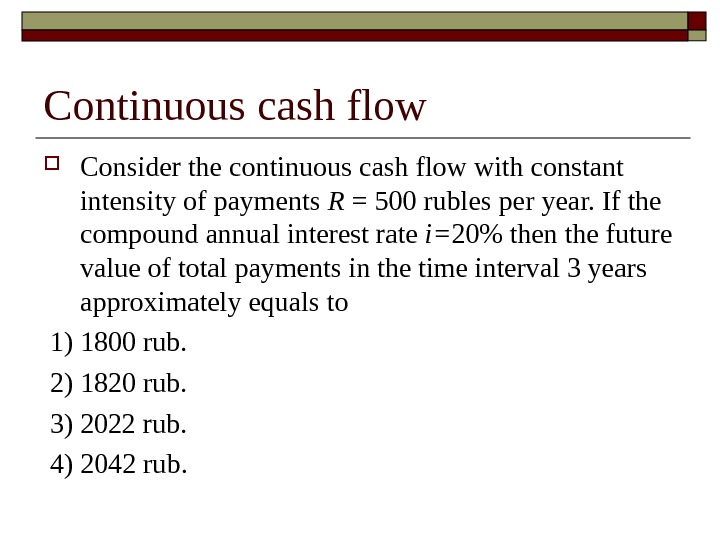
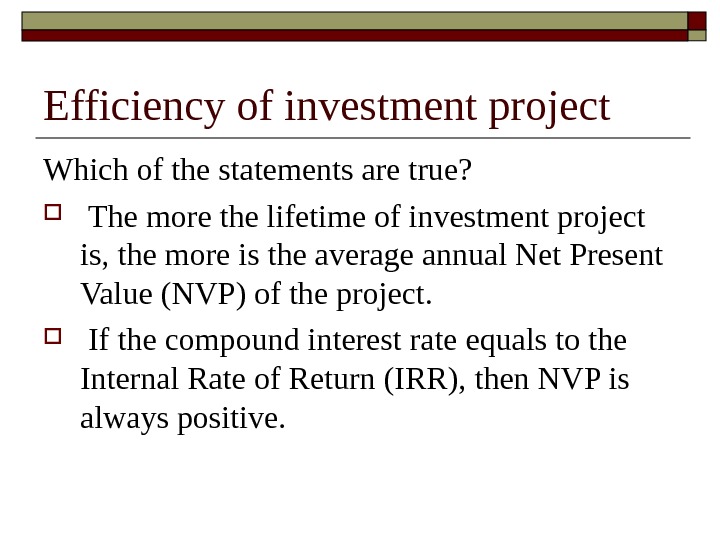
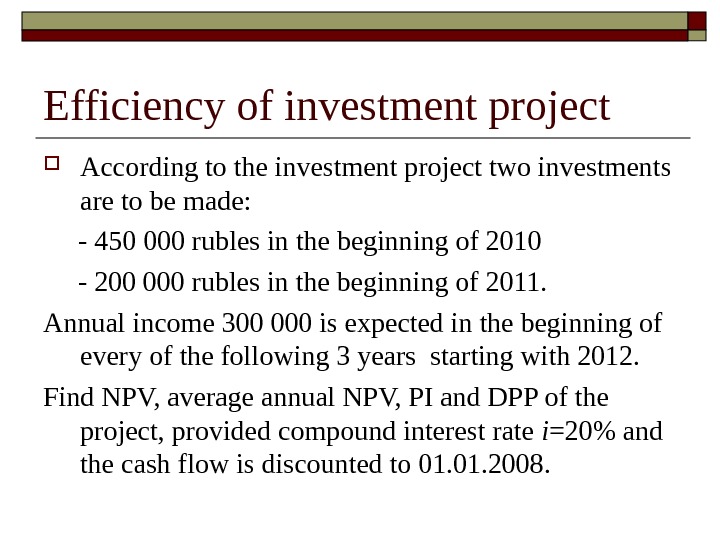
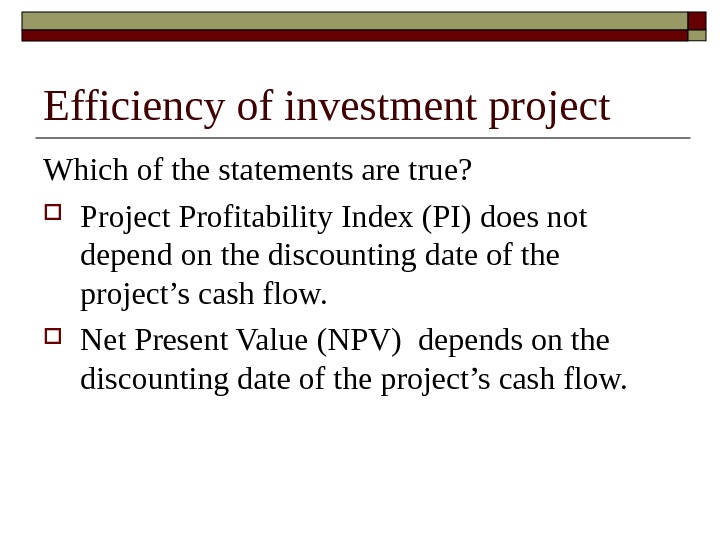
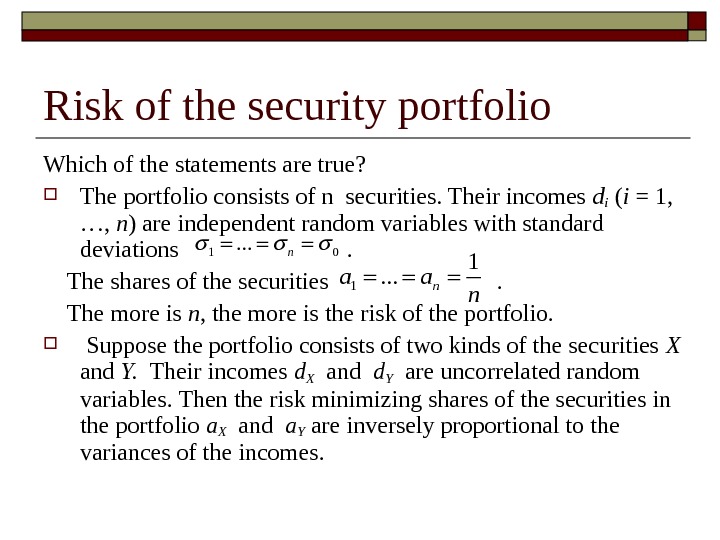
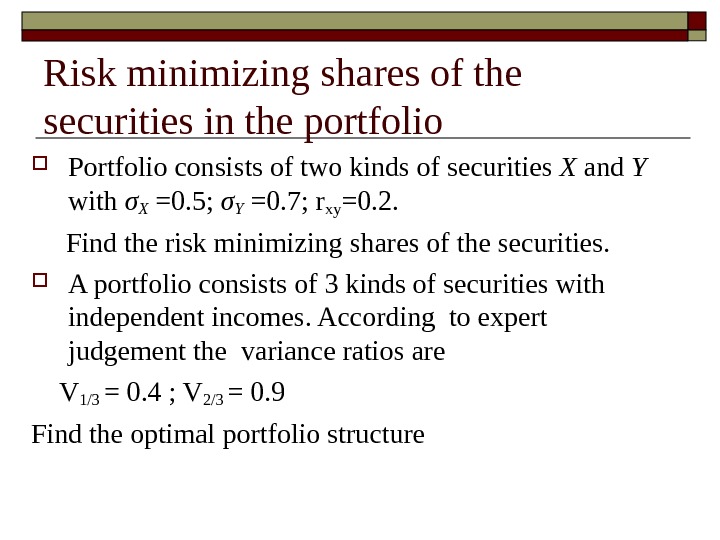
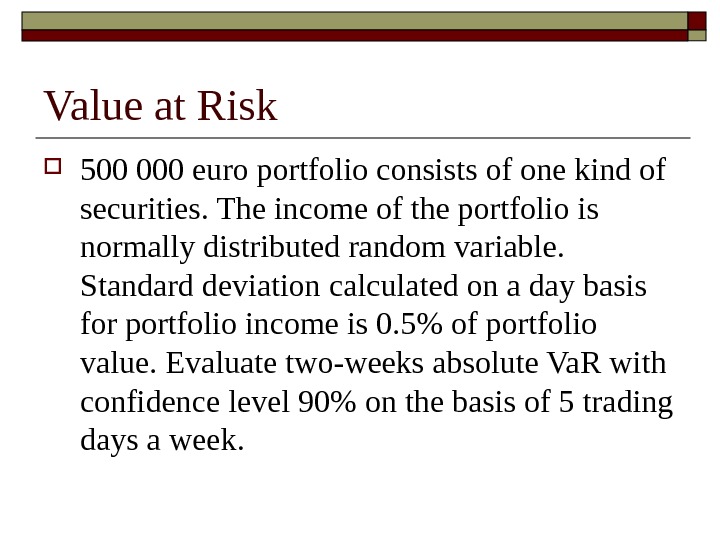
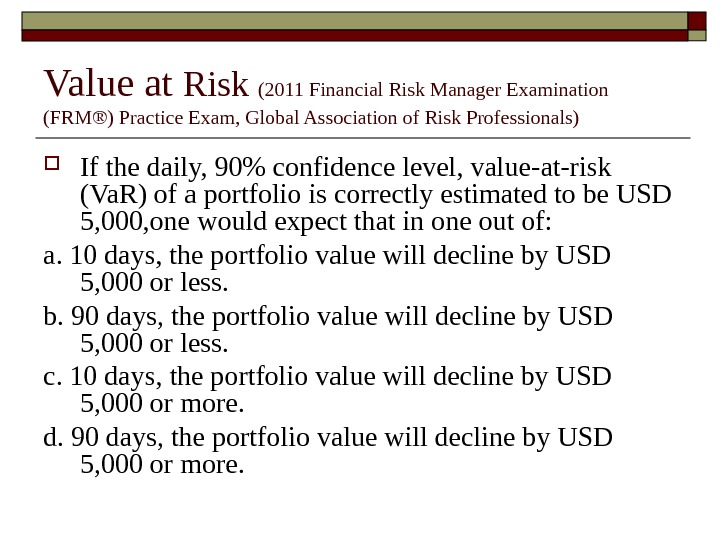

13_prepar_for_test.ppt
- Размер: 266 Кб
- Количество слайдов: 23
Описание презентации Mathematical Models in Finances Valentina Desnitskaya Val. desnitskaya@mail. по слайдам
 Mathematical Models in Finances Valentina Desnitskaya Val. desnitskaya@mail. ru Lecture
Mathematical Models in Finances Valentina Desnitskaya Val. desnitskaya@mail. ru Lecture
 Percentages Which of the statements are true? If you increase the value by 375% you have to multiply the original value by 4. 75. If a is greater by p % than b , then b is p % less than a. The value a increases by p % and then the result increases by q %. The final result is b. Suppose a at first increases by q % and then the result increases by p %, the final result is b’. If b = b’ , then p = q.
Percentages Which of the statements are true? If you increase the value by 375% you have to multiply the original value by 4. 75. If a is greater by p % than b , then b is p % less than a. The value a increases by p % and then the result increases by q %. The final result is b. Suppose a at first increases by q % and then the result increases by p %, the final result is b’. If b = b’ , then p = q.
 Percentages A company’s share price increases from 156. 4 to 187. 2. What is the percentage change? You put $3600 in a gold star savings account, and when the interest is added you have $3794. 4. What rate of interest has been paid, and how does it compare with the 4% offered by a bank deposit account?
Percentages A company’s share price increases from 156. 4 to 187. 2. What is the percentage change? You put $3600 in a gold star savings account, and when the interest is added you have $3794. 4. What rate of interest has been paid, and how does it compare with the 4% offered by a bank deposit account?
 Financial Equivalence Principle Which of the statements are true? Suppose that S 1 and S 2 are two sums of money referred to the moments of time t 1 and t 2. If t 1 S 2 , these sums may be financially equivalent. The financial equivalence of sums of money depends on the way of calculating interest.
Financial Equivalence Principle Which of the statements are true? Suppose that S 1 and S 2 are two sums of money referred to the moments of time t 1 and t 2. If t 1 S 2 , these sums may be financially equivalent. The financial equivalence of sums of money depends on the way of calculating interest.
 Simple Interest Rate Which of the statements are true? Suppose you take a loan P at an annual simple interest rate i. You have to repay S in time period T. The more i is, the more is T. Consider the funding problem with simple interest rate i : the payments S 1 , …, Sm referred to the moments t 1 , …, tm are to be consolidated in one payment The more is the interest rate i , the earlier is the moment of consolidated payout t. 1 m k k S S
Simple Interest Rate Which of the statements are true? Suppose you take a loan P at an annual simple interest rate i. You have to repay S in time period T. The more i is, the more is T. Consider the funding problem with simple interest rate i : the payments S 1 , …, Sm referred to the moments t 1 , …, tm are to be consolidated in one payment The more is the interest rate i , the earlier is the moment of consolidated payout t. 1 m k k S S
 Simple Interest Rate: Mean Interest Rate At time period t 1 simple interest rate is 5% , at time period t 2 simple interest rate is 15%. T = t 1 + t 2 = 10 years. Mean interest rate for time period T equals 12%. Find t 1.
Simple Interest Rate: Mean Interest Rate At time period t 1 simple interest rate is 5% , at time period t 2 simple interest rate is 15%. T = t 1 + t 2 = 10 years. Mean interest rate for time period T equals 12%. Find t 1.
 Simple Interest and Discount Rates A person borrows the sum of money P. He has to pay back the sum S ( S ≠ P ) in T years provided mathematical discounting with annual simple interest rate i is used. If banking discounting with simple discount rate d is used and he has to pay back the same sum S in T years, then i = d.
Simple Interest and Discount Rates A person borrows the sum of money P. He has to pay back the sum S ( S ≠ P ) in T years provided mathematical discounting with annual simple interest rate i is used. If banking discounting with simple discount rate d is used and he has to pay back the same sum S in T years, then i = d.
 Compound Interest Rate Is this statement true? The calculations with compound annual interest rate i are always more profitable for the depositor and less profitable for the bank than the calculations with simple annual interest rate i.
Compound Interest Rate Is this statement true? The calculations with compound annual interest rate i are always more profitable for the depositor and less profitable for the bank than the calculations with simple annual interest rate i.
 Simple and Compound Interest Rates A rich uncle has given you € 5000 which you plan to save for 5 years. Would you prefer to put it in an account offering 7% simple interest or one offering 6% compound interest?
Simple and Compound Interest Rates A rich uncle has given you € 5000 which you plan to save for 5 years. Would you prefer to put it in an account offering 7% simple interest or one offering 6% compound interest?
 Simple, Compound and Continuous Interest Rates If a loan of € 400 is taken out at a rate of annual interest of 18% for 2 years, calculate the final debt if the interest is compounded using relative interest rates (a) quarterly (b) monthly (c) continuously Is this statement true? The force of interest equals to the rate of relative growth of the sum of money.
Simple, Compound and Continuous Interest Rates If a loan of € 400 is taken out at a rate of annual interest of 18% for 2 years, calculate the final debt if the interest is compounded using relative interest rates (a) quarterly (b) monthly (c) continuously Is this statement true? The force of interest equals to the rate of relative growth of the sum of money.
 Compound Discount Rate Choose the item that fits: The compound annual discount rate is 20%. The $10 000 bill is discounted t years before its payout term. If the bill’s owner gets $5 000 then t is (approximately) 1. 0. 44 year 2. 3. 18 year 3. 2. 50 year 4. 3. 89 year
Compound Discount Rate Choose the item that fits: The compound annual discount rate is 20%. The $10 000 bill is discounted t years before its payout term. If the bill’s owner gets $5 000 then t is (approximately) 1. 0. 44 year 2. 3. 18 year 3. 2. 50 year 4. 3. 89 year
 Funding Problem with Compound Interest Rate Choose the item that fits: Two payments : 1000 rubles (payout term 2 years), 5000 rubles (payout term 4 years) are funded in one payment to be paid immediately with compound annual interest rate i=10%. Then the funded sum equals (approximately) to 1) 2424 rubles 2) 3232 rubles 3) 4242 rubles 4) 4343 rubles
Funding Problem with Compound Interest Rate Choose the item that fits: Two payments : 1000 rubles (payout term 2 years), 5000 rubles (payout term 4 years) are funded in one payment to be paid immediately with compound annual interest rate i=10%. Then the funded sum equals (approximately) to 1) 2424 rubles 2) 3232 rubles 3) 4242 rubles 4) 4343 rubles
 Constant Rents Accumulation of fund has the type of constant ordinary annuity at compound interest rate 20%. Annual payment is 20. 000 rubles. Present value of the fund is 60. 000 rubles. Find future value of the rent. In the beginning of each quarter a firm sets aside $3000 for the purchase of new computer equipment. At an interest rate of 2% compound per quarter, how much is in the fund at the end of 4 years?
Constant Rents Accumulation of fund has the type of constant ordinary annuity at compound interest rate 20%. Annual payment is 20. 000 rubles. Present value of the fund is 60. 000 rubles. Find future value of the rent. In the beginning of each quarter a firm sets aside $3000 for the purchase of new computer equipment. At an interest rate of 2% compound per quarter, how much is in the fund at the end of 4 years?
 Rent with constant relative increase of payments Consider a rent with constant relative increase of payments with the rate h: R , R (1+ h ), …, R (1+ h ) n- 2 R (1+ h ) n -1 t 1 , t 2 , t n -1 , t n S is the future value of the rent at the end of the term t n . Suppose S is calculated using compound interest rate i. If i = h , then S is the sum of equal items.
Rent with constant relative increase of payments Consider a rent with constant relative increase of payments with the rate h: R , R (1+ h ), …, R (1+ h ) n- 2 R (1+ h ) n -1 t 1 , t 2 , t n -1 , t n S is the future value of the rent at the end of the term t n . Suppose S is calculated using compound interest rate i. If i = h , then S is the sum of equal items.
 Continuous cash flow Consider the continuous cash flow with constant intensity of payments R = 500 rubles per year. If the compound annual interest rate i= 20% then the future value of total payments in the time interval 3 years approximately equals to 1) 1800 rub. 2) 1820 rub. 3) 2022 rub. 4) 2042 rub.
Continuous cash flow Consider the continuous cash flow with constant intensity of payments R = 500 rubles per year. If the compound annual interest rate i= 20% then the future value of total payments in the time interval 3 years approximately equals to 1) 1800 rub. 2) 1820 rub. 3) 2022 rub. 4) 2042 rub.
 Efficiency of investment project Which of the statements are true? The more the lifetime of investment project is, the more is the average annual Net Present Value (NVP) of the project. If the compound interest rate equals to the Internal Rate of Return (IRR), then NVP is always positive.
Efficiency of investment project Which of the statements are true? The more the lifetime of investment project is, the more is the average annual Net Present Value (NVP) of the project. If the compound interest rate equals to the Internal Rate of Return (IRR), then NVP is always positive.
 Efficiency of investment project According to the investment project two investments are to be made: — 450 000 rubles in the beginning of 2010 — 200 000 rubles in the beginning of 2011. Annual income 300 000 is expected in the beginning of every of the following 3 years starting with 2012. Find NPV, average annual NPV, PI and DPP of the project, provided compound interest rate i =20% and the cash flow is discounted to 01. 2008.
Efficiency of investment project According to the investment project two investments are to be made: — 450 000 rubles in the beginning of 2010 — 200 000 rubles in the beginning of 2011. Annual income 300 000 is expected in the beginning of every of the following 3 years starting with 2012. Find NPV, average annual NPV, PI and DPP of the project, provided compound interest rate i =20% and the cash flow is discounted to 01. 2008.
 Efficiency of investment project Which of the statements are true? Project Profitability Index (PI) does not depend on the discounting date of the project’s cash flow. Net Present Value (NPV) depends on the discounting date of the project’s cash flow.
Efficiency of investment project Which of the statements are true? Project Profitability Index (PI) does not depend on the discounting date of the project’s cash flow. Net Present Value (NPV) depends on the discounting date of the project’s cash flow.
 Risk of the security portfolio Which of the statements are true? The portfolio consists of n securities. Their incomes di ( i = 1, …, n ) are independent random variables with standard deviations . The shares of the securities The more is n , the more is the risk of the portfolio. Suppose the portfolio consists of two kinds of the securities X and Y. Their incomes d X and d. Y are uncorrelated random variables. Then the risk minimizing shares of the securities in the portfolio a X and a. Y are inversely proportional to the variances of the incomes. 1 0. . . n 1 1. . . na a n
Risk of the security portfolio Which of the statements are true? The portfolio consists of n securities. Their incomes di ( i = 1, …, n ) are independent random variables with standard deviations . The shares of the securities The more is n , the more is the risk of the portfolio. Suppose the portfolio consists of two kinds of the securities X and Y. Their incomes d X and d. Y are uncorrelated random variables. Then the risk minimizing shares of the securities in the portfolio a X and a. Y are inversely proportional to the variances of the incomes. 1 0. . . n 1 1. . . na a n
 Risk minimizing shares of the securities in the portfolio Portfolio consists of two kinds of securities X and Y with σX =0. 5; σY =0. 7; rxy =0. 2. Find the risk minimizing shares of the securities. A portfolio consists of 3 kinds of securities with independent incomes. According to expert judgement the variance ratios are V 1/3 = 0. 4 ; V 2/3 = 0. 9 Find the optimal portfolio structure
Risk minimizing shares of the securities in the portfolio Portfolio consists of two kinds of securities X and Y with σX =0. 5; σY =0. 7; rxy =0. 2. Find the risk minimizing shares of the securities. A portfolio consists of 3 kinds of securities with independent incomes. According to expert judgement the variance ratios are V 1/3 = 0. 4 ; V 2/3 = 0. 9 Find the optimal portfolio structure
 Value at Risk 5 00 000 euro portfolio consists of one kind of securities. The income of the portfolio is normally distributed random variable. Standard deviation calculated on a day basis for portfolio income is 0. 5% of portfolio value. Evaluate two-weeks absolute Va. R with confidence level 90% on the basis of 5 trading days a week.
Value at Risk 5 00 000 euro portfolio consists of one kind of securities. The income of the portfolio is normally distributed random variable. Standard deviation calculated on a day basis for portfolio income is 0. 5% of portfolio value. Evaluate two-weeks absolute Va. R with confidence level 90% on the basis of 5 trading days a week.
 Value at Risk (2011 Financial Risk Manager Examination (FRM®) Practice Exam, Global Association of Risk Professionals) If the daily, 90% confidence level, value-at-risk (Va. R) of a portfolio is correctly estimated to be USD 5, 000, one would expect that in one out of: a. 10 days, the portfolio value will decline by USD 5, 000 or less. b. 90 days, the portfolio value will decline by USD 5, 000 or less. c. 10 days, the portfolio value will decline by USD 5, 000 or more. d. 90 days, the portfolio value will decline by USD 5, 000 or more.
Value at Risk (2011 Financial Risk Manager Examination (FRM®) Practice Exam, Global Association of Risk Professionals) If the daily, 90% confidence level, value-at-risk (Va. R) of a portfolio is correctly estimated to be USD 5, 000, one would expect that in one out of: a. 10 days, the portfolio value will decline by USD 5, 000 or less. b. 90 days, the portfolio value will decline by USD 5, 000 or less. c. 10 days, the portfolio value will decline by USD 5, 000 or more. d. 90 days, the portfolio value will decline by USD 5, 000 or more.
 Value at Risk (2011 Financial Risk Manager Examination (FRM®) Practice Exam, Global Association of Risk Professionals) Assume that portfolio daily returns are independently and identically normally distributed. Sam Neil, a new quantitative analyst, has been asked by the portfolio manager to calculate the portfolio Value-at-Risk (Va. R) measure for 10, 15, 20 and 25 day periods. The portfolio manager notices something amiss with Sam’s calculations displayed below. Which one of following VARs on this portfolio is inconsistent with the others? a. VAR(10 -day) = USD 316 b. VAR(15 -day) = USD 465 c. VAR(20 -day) = USD 537 d. VAR(25 -day) = US
Value at Risk (2011 Financial Risk Manager Examination (FRM®) Practice Exam, Global Association of Risk Professionals) Assume that portfolio daily returns are independently and identically normally distributed. Sam Neil, a new quantitative analyst, has been asked by the portfolio manager to calculate the portfolio Value-at-Risk (Va. R) measure for 10, 15, 20 and 25 day periods. The portfolio manager notices something amiss with Sam’s calculations displayed below. Which one of following VARs on this portfolio is inconsistent with the others? a. VAR(10 -day) = USD 316 b. VAR(15 -day) = USD 465 c. VAR(20 -day) = USD 537 d. VAR(25 -day) = US
